Deliveries still sluggish – orders strong with 300 new bookings as Airbus sets another all-time backlog record

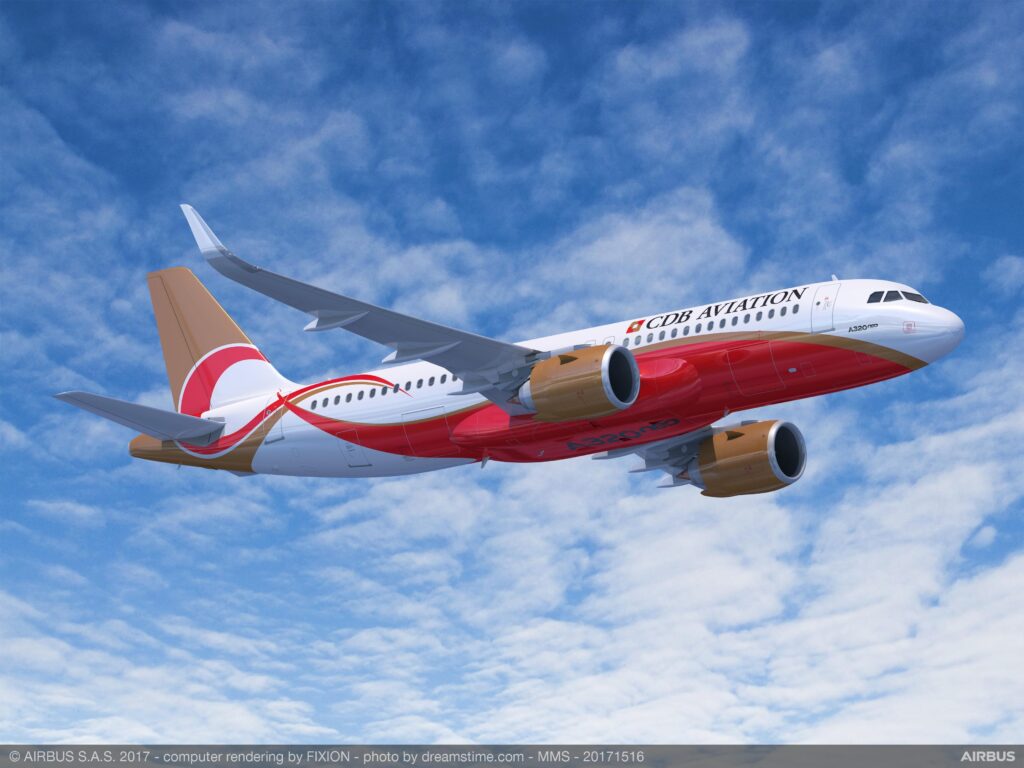
In September, deliveries were slow but orders were strong – in particular for Airbus, which set yet another all-time backlog record for the commercial aircraft industry. On the deliveries front, Boeing handed over 33 commercial jets (compared to 40 in August and 43 in July) while Airbus delivered 50 units, up from 47 last month. This compares to 27 deliveries for Boeing and 55 for Airbus in September of last year. Boeing’s deliveries are currently affected by a major strike involving 33,000 of its unionized workers. In September, 27 Boeing 737 MAX were handed over to customers, down from 32 last month. Regulators have allowed Boeing to produce up to 38 737s per month, however, the company has opted to slow its production until it feels ready to return to the official production rate of 38 jets per month. With 27-34 737 MAX’s shipped out monthly in the June-September timeframe, Boeing is still hovering well below the official rate.
Year-to-date, Boeing and Airbus have delivered 291 and 497 aircraft compared to 371 and 488, respectively, during the first three quarters of 2023. As of September, Boeing is 80 deliveries behind compared to last year’s totals to date, while Airbus is eight deliveries ahead. In 2023, in total, Boeing and Airbus delivered 528 and 735 aircraft compared to 480 and 663, respectively, in 2022. In 2023, Airbus won the deliveries crown for the fifth consecutive year.
Following a more than challenging 2020 due to the COVID-19 pandemic, 2021-23 were recovery years for the two largest commercial plane makers. For Airbus, 2024 is expected to be another year of recovery on the deliveries front, however, the company is currently struggling to push out aircraft fast enough to keep up with demand, and it appears an insufficient supply of engines is mainly at fault. To reach its revised target of 770 units delivered this year (down from a target of 800 at the beginning of the year), Airbus will have to push out 91 jets, on average, per month during the fourth quarter. While Airbus has traditionally finished the year on a very high note, churning out 273 aircraft in one quarter would be quite a feat. Last year, Airbus delivered 247 units in Q4 compared to 297 in 2018 and 292 in 2019 in the pre-COVID years. Turning our attention to 2025, despite the company’s deliveries woes, we continue to expect a new all-time delivery record from Airbus. Boeing will take a step back on the deliveries front this year as it is focusing on safety and working to fix its quality system. But we can expect a sharp surge in Boeing shipments in 2025. However, Boeing still has quite a way to go before setting new all-time company deliveries records. In 2018, before COVID-19 and the first 737 MAX grounding, Boeing delivered 806 jets, a level that will likely not be recaptured before 2027. Airbus’ record high of 863 shipments was set in 2019, a level that should be surpassed in 2025. Also, Airbus is expected to retain their deliveries lead for the foreseeable future due to the company’s comfortable backlog lead over its American rival. Before 2019, Boeing had out-delivered Airbus every year since 2012.
As indicated above, in September, Boeing delivered only 33 jets, including 28 737s (27 MAXs / 1 NG), one 767, and four 787s. For most of last year, the 737 program was producing aircraft at an official rate of 31 per month. At the end of 2023, the program completed its transition to 38 aircraft per month. However, increased quality checks and audits by regulators in the aftermath of the Alaska Airlines Flight 1282 incident mean that Boeing is currently producing 737 MAXs at a lower rate. In March, Boeing Chief Financial Officer, Brian West, stated: “We are the ones who made the decision to constrain rates on the 737 program below 38 per month until we feel like we’re ready.” At the company’s second quarter earnings call in late July, Boeing announced it expects to return to its official production rate by the end of the year. Boeing’s plans to increase production to approximately 50 737 MAX jets per month in the 2025/26 timeframe are still in effect. The target of 50 per month compares to the pre-crash/pre-pandemic rate of 52 737s per month in 2018. Last year, it was reported that the company is planning to boost production to 52 jets per month by January 2025. The company is still producing 737 NGs but now only has 12 737-800s remaining in backlog – of which 10 are P-8 Poseidons for the U.S. Navy and allies – as well as an additional two 737-700s that will be converted into E-7A Airborne Early Warning and Control (AEW&C) aircraft for the U.S. Air Force.
The 787 program will be ramping up production next year. In January of this year, the 787 production rate was raised to five per month with a target of 10 per month by 2025/26. However, Boeing has for now reduced the 787 rate to four before returning to five by the end of the year.
The 767 program is currently producing jets at a rate of three units per month, a mix of KC-46 tankers (based on the 767-2C) and 767-300F freighters. Boeing has just announced plans to end production of the 767-300F in 2027, after which the 767-2C is to be the sole 767 version in production. The company indicated that production of the 767 freighter will end once current orders are fulfilled. As of the end of September 2024, Boeing had unfilled orders for 29 767-300Fs, including 17 for UPS and 12 for FedEx.
The 777 program is currently pushing out aircraft at a rate of three per month. Most aircraft in backlog are 777 freighters, with only five 777-300ERs left. By the 2025/26 timeframe, Boeing expects to be delivering four 777s per month. The 777 program was expected to get a new addition in late 2023 with the delivery of the first 777X (777-9), however, the 777X’s entry into service was postponed to 2025. Recently, the service entry was pushed out once more, this time to 2026. Boeing will also launch a 777X-based freighter (777-8F) with initial delivery in 2028 – recently postponed by one year just like the 777-9.
In September, Airbus delivered just 50 jets, including five A220s, 41 A320s (all NEO), one A330, and three A350s. On average, the company delivered 48 A320s per month in 2023 compared to 43 in 2022 and 44 year-to-date. Production is currently being increased, however, Airbus is no longer releasing their production rate changes and prefers to announce in what year they will reach a certain rate. At this time, despite slow shipments in August and September, we consider the unofficial A320 production rate to be 52 per month with further increases expected in the fourth quarter. Airbus is working with its supply chain to increase A320 production to 75 aircraft per month by 2027. Previously, the target of 75 was expected to be reached in 2026, however, in June of this year, Airbus pushed the target out by a year as suppliers are simply unable to keep up with demand. Also, Airbus has reduced its 2024 deliveries target from 800 to 770. The A320 program was expected to reach a monthly rate of 65 by late 2024, however, while Airbus has not specified whether this target has also been pushed out, we would now not expect this level of production to be reached before well into 2025. The commercial aircraft fleet is getting a new addition this year with the entry-into-service of the A321XLR. Final assembly of the first production aircraft commenced in December 2023 with entry-into-service expected to take place in Q4 2024 (most likely October). On 19 July, Airbus announced that the A321XLR has received its EASA type certification. This fall, the first A321XLR production aircraft is set to roll of the production line for delivery to launch customer Iberia, which will use its first aircraft on transatlantic flights.
The A220, meanwhile, is being produced at an unofficial rate of seven aircraft per month, with a monthly production rate of 14 expected by 2026. Airbus is reportedly considering to introduce a stretch version of the A220.
The A330 production rate was increased from two aircraft per month to three at the end of 2022, with an increase to four per month expected this year. The A350 production rate was raised to six per month at the end of 2023 in line with Airbus’ announcements. Airbus expects to produce 10 A350s per month by 2026 and 12 by 2028.
Turning to the September orders review, in terms of reported bookings, Boeing had a solid month and reported 65 gross orders from two different customers. Boeing had no cancellations in September. Both orders were placed by two undisclosed customers ordering 54 737 MAXs and 11 777Fs, respectively. Year-to-date, Boeing has accumulated 272 net new orders (315 gross orders), compared to 724 net new orders (848 gross orders) after the first nine months of last year. Last year’s figures include Paris Air Show held in June 2023, where the general ordering activity was much stronger than at Farnborough this year. In 2023, Boeing booked a total of 1,314 net new orders (1,456 gross orders) – before ASC 606 changes – compared to 774 net new orders (935 gross orders) in 2022. Please note that for comparison reasons, we do not include Boeing’s so-called ASC 606 accounting adjustments in the numbers reported in this article and regard net new orders as gross orders minus cancellations.

In September, Airbus had a very strong month on the orders front and booked orders from three customers for a total of 235 jets (gross orders) and reported no cancellations. The largest order (by # of aircraft) was placed by an undisclosed customer and features 55 A321neos, 20 A320neos as well as five A350-900s and five A350-1000s. CDB Leasing, the leasing arm of China Development Bank, booked 65 A321neos and 15 A320neos. Finally, Cebu Pacific ordered 70 A321neos. Out of 235 Airbus aircraft ordered this month, 190 were A321neos. Year-to-date, Airbus has accumulated 667 gross orders (19 cancellations => 648 net new orders), compared to 1,241 net new orders (1,280 gross orders) after the first nine months of last year. In 2023, Airbus won the orders crown for the fifth consecutive year booking an astounding 2,094 net new orders (2,319 gross orders), compared to 820 net new orders (1,078 gross orders) in 2022.
At the end of September, following a strong orders haul, Airbus set a new all-time backlog record for the commercial aircraft industry. The company reported a backlog of a staggering 8,749 jets, of which 7,806, or 89 percent, were A220 and A320ceo/neo family narrowbodies. Airbus’ old all-time backlog record of 8,626 jets was set in March of this year. By the end of last month, Boeing’s backlog (total unfilled orders before ASC 606 adjustment) was 6,197 aircraft, of which 4,770, or 77 percent, were 737 NG/MAX narrowbody jets. Boeing’s all-time backlog record of 6,259 aircraft was set in March 2024. The number of Airbus aircraft to be built and delivered represents 10.1 years of shipments at the 2019 production level (the pre-pandemic level), or 11.7 years based on the 2023 total. In comparison, Boeing’s backlog would “only” last 7.7 years at the 2018 level (the most recent “normal” year for Boeing), or 11.9 years based on 2023 deliveries. Boeing’s book-to-bill ratio year-to-date, calculated as net new orders divided by deliveries, is 0.93 with Airbus coming in higher at 1.30. This means that Boeing is currently tapping into its backlog, while Airbus is receiving 1.3 new orders for every aircraft it delivers. Boeing’s book-to-bill ratio last year was 2.49 with Airbus coming in even higher at 2.85. This means that both companies received well over two new firm orders for every aircraft delivered.
2024 Forecast
Forecast International’s Platinum Forecast System is a breakthrough in forecasting technology that provides 15-year production forecasts. The author has used the Platinum Forecast System to retrieve the latest delivery forecast data from the Civil Aircraft Forecast product. For 2024, Forecast International’s analysts currently expect Boeing and Airbus to deliver 395 and 764 commercial jets, respectively. Please note that these figures exclude militarized variants of commercial platforms such as Boeing’s P-8 Poseidon maritime patrol aircraft and KC-46 Pegasus tanker and Airbus’ A330 MRTT tanker.
In its current year guidance, despite sluggish deliveries these past few months, Airbus still expects to deliver 770 planes in 2024 (target reduced in July from 800), compared to 735 delivered in the previous year. Meanwhile, Boeing decided to forgo issuing a 2024 production forecast as it focuses on safety and quality improvements in the aftermath of the Alaska Airlines incident in January. Boeing reports third quarter results on 23 October followed by Airbus a week later on 30 October.
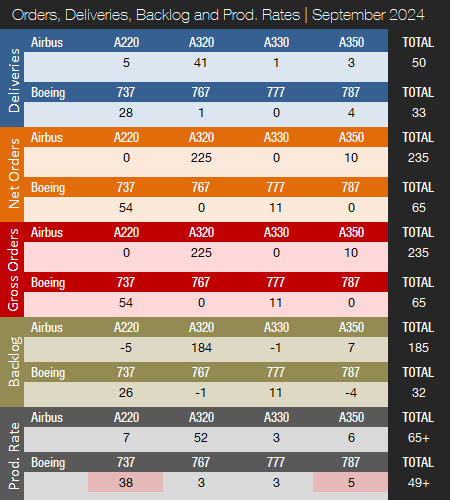
Note: Light red color means the program is temporarily producing at a lower rate than what is indicated in the table.
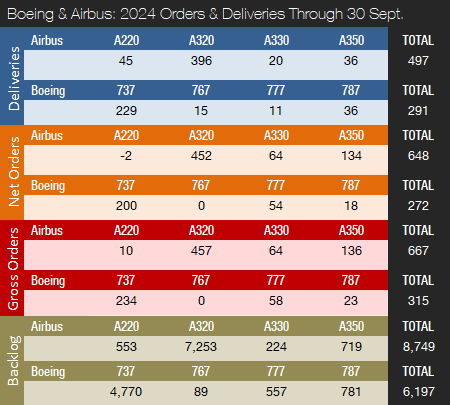
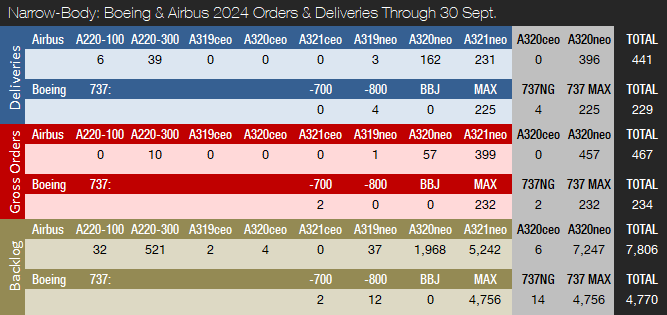

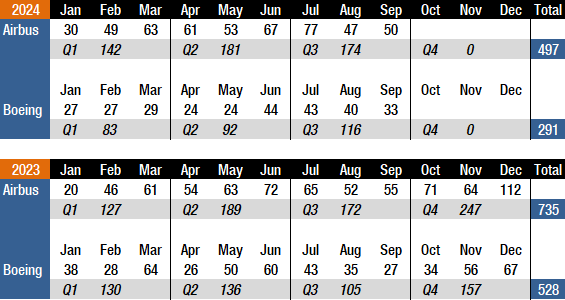
References:
- https://www.forecastinternational.com/platinum.cfm
- http://www.boeing.com/commercial/#/orders-deliveries
- https://www.airbus.com/aircraft/market/orders-deliveries.html
- https://boeing.mediaroom.com/2024-10-08-Boeing-Announces-Third-Quarter-Deliveries
- https://flightplan.forecastinternational.com/2024/10/16/boeing-to-end-767-300f-production-in-2027-postpones-777x-delivery-start/
- https://www.airbus.com/en/newsroom/press-releases/2024-10-cebu-pacific-orders-70-a321neo
- https://www.reuters.com/business/aerospace-defense/slow-airbus-deliveries-raise-fresh-questions-over-annual-target-2024-09-26/
- https://www.cdbaviation.aero/airbus-order/
Forecast International’s Civil Aircraft Forecast covers the rivalry between Airbus and Boeing in the large airliner sector; the emergence of new players in the regional aircraft segment looking to compete with Bombardier, Embraer, and ATR; and the shifting dynamics within the business jet market as aircraft such as the Bombardier Global 7000, Cessna Hemisphere, and Gulfstream G600 enter service. Also detailed in this service are the various market factors propelling the general aviation/utility segment as Textron Aviation, Cirrus, Diamond, Piper, and a host of others battle for sales and market share. An annual subscription includes 65 individual reports, most with a 10-year unit production forecast. Click here to learn more about FI’s Aviation Systems forecasting products.
Kasper Oestergaard is an expert in aerospace & defense market intelligence, fuel efficiency in civil aviation, defense spending and defense programs. Mr. Oestergaard has a Master's Degree in Finance and International Business from the Aarhus School of Business - Aarhus University in Denmark. He has written four aerospace & defense market intelligence books as well as numerous articles and white papers about European aerospace & defense topics.



